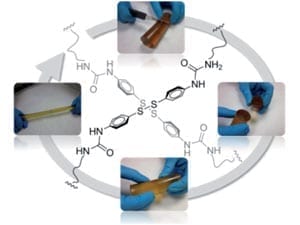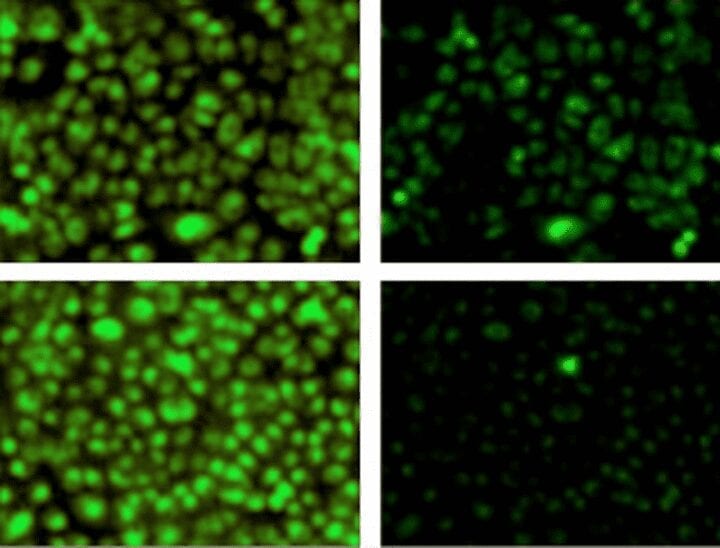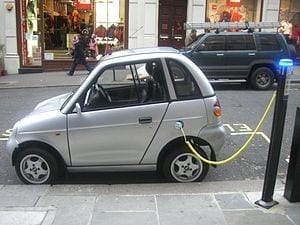
Scientists report the first self-healing thermoset elastomer that requires no intervention to induce its repair.
Self-healing polymers mend themselves by reforming broken cross-linking bonds. However, the cross-linking healing mechanism usually requires an external stimulus.
Triggers to promote bond repair include energy inputs, such as heat or light, or specific environmental conditions, such as pH. Self-healing polymers that can spontaneously achieve quantitative healing in the absence of a catalyst have never been reported before, until now.
Ibon Odriozola previously came close when his group at the CIDETEC Centre for Electrochemical Technologies in Spain developed self-healing silicone elastomers using silver nanoparticles as cross-linkers. Unfortunately, an applied external pressure was required and the expensive sliver component disfavoured commercialisation. But now they have achieved their goal to prepare self-healing elastomers from common polymeric starting materials using a simple and inexpensive approach.
An industrially familiar, permanently cross-linked poly(urea–urethane) elastomeric network was demonstrated to completely mend itself after being cut in two by a razor blade. It is the metathesis reaction of aromatic disulphides, which naturally exchange at room temperature, that causes regeneration.
Ibon stresses the use of commercially available materials is important for industrial applications. He says the polymer behaves as if it was alive, always healing itself and has dubbed it a “terminator” polymer – a tribute to the shape-shifting, molten T-1000 terminator robot from the Terminator 2 film. It acts as a velcro-like sealant or adhesive, displaying an impressive 97% healing efficiency in just two hours and does not break when stretched manually.
David Mecerreyes, a polymer chemistry specialist at the University of the Basque Country in Spain, sees opportunities to use this elastomer to improve the security and duration of many plastic parts, for example in cars, houses, electrical components and biomaterials.
The Latest Bing News on:
Self-healing material
- A month of healing — just what we needon May 8, 2024 at 1:40 pm
Healing is the special power of the new Jewish month of Iyar, which begins tonight at sundown. The word Iyar (אייר) is a “roshei teivos” (first letter acronym) of “אני יי רופאך,” which means “I am God ...
- Believe it or not! Potholes can now be self healedon May 8, 2024 at 3:15 am
The infused bitumen in asphalt deteriorates, leading to erosion of the top surface and formations of cracks over a period of time.
- Wild Sumatran orangutan uses medicinal plant to treat facial woundon May 5, 2024 at 10:28 pm
Researchers documented the first observed case of a wild Sumatran orangutan actively treating a wound using a medicinal plant, offering insights into the origins of self-medication in non-human ...
- Ape Treating His Wound Using Medicinal Plant is a World First for a Wild Animalon May 5, 2024 at 11:26 am
An ape was seen treating a wound using a medicinal plant for the first time. Days later the Sumatran orangutan had successfully healed it.
- Self-healing, magical highways to resolve pothole situation in India: NHAI's prospective plan explainedon May 5, 2024 at 2:08 am
NHAI explores self-healing materials with steel fibers and bitumen to reduce potholes, extend road life, and lower maintenance costs in India. Stay up ...
- Hope and healing possible for those hurt by pornography, Elder Renlund sayson May 4, 2024 at 8:19 pm
Clay Olsen, founder of Fight the New Drug, said hope, community, service and spirituality are integral to recovering from pornography.
- Wild orangutan engaged in never-before-seen wound-healing behavioron May 2, 2024 at 5:00 pm
Because Rakus repeatedly applied the poultice only to the wounded area, the team feels it is safe to say that the animal was engaging in self-treatment. As such, this is the first reported ...
- Scientists spot an orangutan using a plant to treat his own wound in the wildon May 1, 2024 at 5:00 pm
At the very end of this process, he applied more solid plant material on the wound ... detailed logs of Rakus’ behavior through the self-healing process, noting his activities every two minutes.
- Building Roads Of Tomorrow: NHAI To Build Self-Repairing Highways To Combat Potholeson May 1, 2024 at 6:55 am
The National Highways Authority of India (NHAI) is spearheading efforts to introduce roads that possess the remarkable ability to repair themselves ...
- Self-Healing Materials: Pioneering a New Era of Resilience and Durabilityon April 30, 2024 at 12:05 pm
What are Self-Healing Materials? Self-healing materials are a class of advanced materials that have the ability to autonomously repair damage and restore their original properties without external ...
The Latest Google Headlines on:
Self-healing material
[google_news title=”” keyword=”Self-healing material” num_posts=”10″ blurb_length=”0″ show_thumb=”left”]
The Latest Bing News on:
Self-healing polymers
- Self-Healing Materials Market Estimated to Reach US$ 15.57 billion by 2032, Fueled by Infrastructure Surge in Developing Economieson April 26, 2024 at 8:03 am
The self-healing materials industry size estimated at US$ 1.61 billion in 2022 is anticipated to grow at a CAGR of 25.5% from 2022 to 2032. Materials that are capable of self-healing are stimulated by ...
- Mechanochemistry strips cargo molecules from a loaded rotaxaneon April 10, 2024 at 5:00 pm
In principle, a sudden force could release these ingredients to generate new polymers that repair a damaged region of material. “The ultimate goal would be to create an autonomous self-healing ...
- Molecular Device Triggers Drug Delivery and Self-Healing Materialson April 10, 2024 at 5:00 pm
The new approach involves two polymer chains attached to a central ring-like structure ... Looking ahead, the researchers aim to delve deeper into self-healing applications, exploring whether two ...
- New molecular device unlocks potential for targeted drug delivery and self-healing materialson April 10, 2024 at 8:27 am
The new approach involves two polymer chains attached to a central ... Looking ahead, the researchers aim to delve deeper into self-healing applications, exploring whether two different types ...
- Unbreakable Design: The Polymer Mechanochemistry of Self-Healing Materialson October 18, 2023 at 11:14 pm
What if we could invent materials that can repair themselves when damaged? Polymer molecules in various states – solid, melt, solution – are susceptible to covalent bond changes in response to ...
- Dominik Konkolewicz receives the Royal Society of Chemistry’s 2022 Polymer Chemistry Lectureship Awardon June 28, 2022 at 4:35 am
Konkolewicz researches responsive or “smart” polymer materials and materials that contain both synthetic and biological components. He was awarded an NSF Career grant for research on self-healing ...
- 'Terminator' polymer that regenerates itselfon September 16, 2013 at 2:14 am
Scientists in Spain have reported the first self-healing polymer that spontaneously and independently repairs itself without any intervention. The new material could be used to improve the security ...
The Latest Google Headlines on:
Self-healing polymers
[google_news title=”” keyword=”Self-healing polymers” num_posts=”10″ blurb_length=”0″ show_thumb=”left”]










